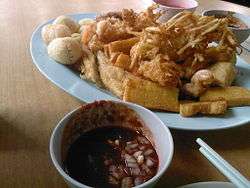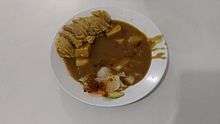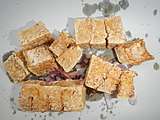Ngo hiang
 | |
| Alternative names | Heh gerng (China); lor bak (Indonesia, Malaysia, Singapore); que-kiam, kikiam, kikyam, kekiam, ngohiong (Philippines) |
|---|---|
| Place of origin | Fujian, China |
| Region or state | Fujian, China; Hokkien-speaking areas; Indonesia, Malaysia, Philippines, Singapore, Thailand |
| Main ingredients | Various meats and vegetables, five spice powder, beancurd skin |
| Ngo hiang | |||||||||||
| Traditional Chinese | 五香 | ||||||||||
|---|---|---|---|---|---|---|---|---|---|---|---|
| Simplified Chinese | 五香 | ||||||||||
| Hokkien POJ | ngó͘-hiang | ||||||||||
| Literal meaning | five spices | ||||||||||
| |||||||||||
Ngo hiang (Chinese: 五香; Pe̍h-ōe-jī: ngó͘-hiang), also known as heh gerng (Chinese: 虾卷; Pe̍h-ōe-jī: hê-kǹg) or lor bak (Chinese: 五香滷肉; Pe̍h-ōe-jī: ngó͘-hiong-ló͘-bah) is a unique Hokkien and Teochew dish widely adopted in Indonesia, Malaysia, the Philippines (where it is known as kikiam, que-kiam, or ngohiong),[1] Singapore, and Thailand; in addition to its place of origin in eastern China.
It is essentially a composition of various meats and vegetables and other ingredients, such as a sausage-like roll consisting of minced pork and prawn (or fish) seasoned with five-spice powder (Hokkien: 五香粉, ngó͘-hiong-hún) after which it is named, rolled inside a beancurd skin and deep-fried, lup cheong, cucumber, century egg, ginger, deep-fried egg, deep-fried beancurd, fishball and many others.[2] It is usually served with chili sauce and a house-special sweet sauce. Many stalls in Singaporean food courts and hawker centres sell fried bee hoon with ngo hiang; this combination is common for breakfast and lunch. In Indonesia, people enjoy ngo hiang with sambal sauce.
See also

- Fishcake
References
- ↑ "Kikiam". Ang Sarap. Retrieved 4 July 2018.
- ↑ "Ngoh Hiang (Chinese Five-Spice Pork Roll) recipe". Rasa Malaysia. Retrieved 17 July 2011.


